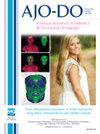喷砂与浮石两种牙釉质制剂后下颌固位体粘接失败率的比较:一项为期18个月的随机对照试验
IF 3
2区 医学
Q1 DENTISTRY, ORAL SURGERY & MEDICINE
American Journal of Orthodontics and Dentofacial Orthopedics
Pub Date : 2025-08-28
DOI:10.1016/j.ajodo.2025.04.015
引用次数: 0
摘要
文献中提出了几种固定固位体粘接的方案,但没有形成明确的共识。本研究旨在比较牙釉质表面喷砂或浮石处理后下颌犬-犬zachrisson型固位体粘接失败率,为期18个月。方法获得伦理批准。即将进入保留期的患者于2019年10月至2021年1月在当地大学医院招募。患者随机分为50 μm氧化铝颗粒喷砂组(实验组)和浮石组(对照组)。入选标准包括最小年龄为11岁,所有下颌门牙和犬齿存在,无活动性龋齿病变,无修复或牙周病。所有的电线都是由同一个操作员接的。主要结果是任何首次固位体粘接失败,由2名评估者在粘接后3、6、9、12、15和18个月记录。钢丝骨折和意外不良运动作为次要结局。随机化序列通过CleanWeb平台(Telemedicine Technologies S.A.S, Paris, France)通过可变大小的块生成。评估员和统计人员对小组分配是不知情的。各组间比较采用Pearson χ2检验。进行Kaplan-Meier生存分析,并用log-rank检验对各组进行比较。结果共纳入患者88例,平均年龄16.5岁,四分位数差3岁,每组44例。最终分析了82例患者(实验组38例,对照组44例)。18个月时喷砂组和浮石组首次粘结失败次数分别为3/38(7.9%)和11/44 (25.0%)(Pearson χ2检验,P = 0.04)。95%置信区间的相对危险度为0.32(0.10-0.96)。喷砂组18个月生存率93%显著高于浮石组75% (log-rank检验,P = 0.02)。在这18个月的随访中,没有钢丝骨折的记录。在7.1%的患者中,除了一些意想不到的不良牙齿运动外,没有观察到严重的伤害。结论牙釉质喷砂与单纯浮石相比,下颌固位器粘接失败率降低了3倍,具有统计学意义和临床意义。该试验已在ClinicalTrials.gov注册,注册号NCT03954145。试验开始前未公布试验方案。无资金或利益冲突申报。本文章由计算机程序翻译,如有差异,请以英文原文为准。
Comparison of bonding failure rates of mandibular retainers after 2 enamel preparations – sandblasting vs pumicing: An 18-month randomized controlled trial
Introduction
Several protocols have been suggested in the literature to bond fixed retainers without a clear emerging consensus. This study aimed to compare, over 18 months, the bonding failure rate of mandibular canine-to-canine Zachrisson-type retainer after either sandblasting or pumicing the enamel surface before bonding.
Methods
Ethical approval was obtained. Patients about to enter their retention phase were recruited from October 2019 to January 2021 at the local University hospital. Patients were block-randomized either in the 50 μm aluminum oxide particles sandblasting group (experimental) or the pumicing group (control). Eligibility criteria included minimal age of 11, presence of all mandibular incisors and canines, no active carious lesion, no restoration nor periodontal disease. All wires were bonded by the same operator. The primary outcome was any first-time retainer bonding failure, recorded by 2 assessors at 3, 6, 9, 12, 15, and 18 months after bonding. Wire fractures and unexpected adverse movements were registered as secondary outcomes. The randomization sequence was generated via the CleanWeb platform (Telemedicine Technologies S.A.S, Paris, France) by blocks of variable size. Assessors and statisticians were blinded to group assignments. Groups were compared with Pearson’s χ2 test. A Kaplan-Meier survival analysis was performed, and groups were compared with a log-rank test.
Results
Eighty-eight patients (mean age, 16.5 years; interquartile range, 3 years) were recruited, and 44 patients were randomized into each group. Eighty-two patients (experimental, 38; control, 44) were finally analyzed. At 18 months, the number of first-time bonding failures was respectively 3/38 (7.9%) and 11/44 (25.0%) among the sandblasting and pumicing groups (Pearson’s χ2 test, P = 0.04). Relative risk with a 95% confidence interval was 0.32 (0.10-0.96). The 18-month survival 93% rate in the sandblasting group was significantly different from the 75% rate in the pumicing group (log-rank test, P = 0.02). No wire fracture was recorded during this 18-month follow-up. No serious harm was observed except for some unexpected adverse dental movements in 7.1% of patients.
Conclusions
Enamel sandblasting leads to a statistically and clinically significant 3-fold reduction in the bonding failure rate of mandibular bonded retainers compared with simple pumicing.
Registration
The trial was registered on ClinicalTrials.gov ID NCT03954145.
Protocol
The protocol was not published before trial commencement.
Funding
No funding or conflict of interests to be declared.
求助全文
通过发布文献求助,成功后即可免费获取论文全文。
去求助
来源期刊
CiteScore
4.80
自引率
13.30%
发文量
432
审稿时长
66 days
期刊介绍:
Published for more than 100 years, the American Journal of Orthodontics and Dentofacial Orthopedics remains the leading orthodontic resource. It is the official publication of the American Association of Orthodontists, its constituent societies, the American Board of Orthodontics, and the College of Diplomates of the American Board of Orthodontics. Each month its readers have access to original peer-reviewed articles that examine all phases of orthodontic treatment. Illustrated throughout, the publication includes tables, color photographs, and statistical data. Coverage includes successful diagnostic procedures, imaging techniques, bracket and archwire materials, extraction and impaction concerns, orthognathic surgery, TMJ disorders, removable appliances, and adult therapy.

 求助内容:
求助内容: 应助结果提醒方式:
应助结果提醒方式:


